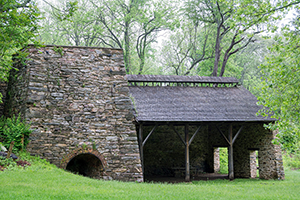 Catoctin Furnace
Catoctin Furnace
The history of Catoctin Furnace represents, in microcosm, the history of the Industrial Revolution in America. From 1776 to 1903 iron companies mined the rich ore banks near Catoctin Mountain, smelted it in furnaces, and cast both raw pig iron and iron implements of every description. The earliest settlers to enter the Monocacy River Valley at the foot of Catoctin Mountain arrived in the 1730s. As is usual in pioneer societies, the settlers pursued agriculture as their primary livelihood. However, after the discovery of rich ore deposits, industrialization swept into the valley.
Four brothers, James, Baker, Roger and Thomas Johnson, began to capitalize upon the valley’s industrial potential on the eve of the American Revolution. They bought land at the foot of the Catoctin Ridge and began construction of an iron furnace. The Johnson furnace was in blast by 1776 and produced ammunition for the Continental Army including shells fired during the siege of Yorktown. Following independence, Thomas Johnson became Maryland’s first governor.
The furnace site grew into a village complex with a concentration of specialized workers. A charcoal house, casting house, foundry, forge, stables, wagon sheds, saw mill, store, and church were all necessary to the iron operation, not to mention housing for miners, colliers, furnace fillers, founders, forge men, foremen, blacksmiths and other skilled workers.
Enslaved Africans provided a large part of the labor force at Catoctin Furnace in the early days. It was common for enslaved African laborers to be used in iron manufacture in the mid-Atlantic. The roles as well as first (and only) anglicized name of some enslaved individuals at Catoctin Furnace are clearly stated in the 1809 will of Baker Johnson. Johnson enslaved more than 80 people including men such as Collier Sam and Waggoners Henry and Harvey. Highly skilled and experienced, these enslaved craftsmen worked as blacksmiths, colliers, founders, and forge men. They in turn taught youths these skilled and valuable trades. In addition to their roles in the making of iron, members of the enslaved community toiled in the vineyard and at other agrarian tasks on large farms surrounding the furnace. They also worked as domestic servants for the ironmasters and their families.
By the middle of the 19th century, the number of enslaved workers at Catoctin declined sharply as large numbers of European immigrant workers moved into the area. Hiring European immigrant labor was cheaper than keeping a large enslaved population to work at the furnace. Enslaved Catoctin Furnace workers may have been sold to buyers in southern states where the demand for and resultant monetary value of enslaved workers remained high. A similar scenario occurred at Georgetown University in 1838 when 272 slaves owned by the Jesuit community were sold to plantations in Louisiana to finance the expansion of the University.
Throughout the 19th century, periods of instability, changes and modernization characterized the industry at Catoctin Furnace. In 1857, “Isabella,” a sophisticated new furnace powered by steam-operated machinery and a 33-foot-high furnace stack was added to the complex. “Isabella” was in continuous blast until 1893 and is still standing today. In 1873 a third stack was built about 140 feet south of “Isabella”. Named “Deborah,” this new stack was a steam- and water powered, coal fired furnace with a daily capacity of 35 tons of pig. It was built in hopes of reviving the failing Catoctin Furnace complex, but in 1903 Catoctin Furnace was forced to shut down due to its unprofitability. “Deborah” was dismantled two years later.
Catoctin Furnace was the victim of changing technology and transportation access. Today, the stack known as “Isabella” is the focal point of the Catoctin Furnace remains. The 1858 casting shed has been reconstructed next to it. Running northwardly from the complex is a short tramway constructed in the mid 19th century to connect the furnace with ore banks a bit over a mile away just west of US-15. Just south of the furnace on Maryland Route 806 are stone and log houses originally occupied by company workers. An interpretative trail connects the furnace area to the Museum of the Ironworker and the center of the village. The majority of the village houses are now privately owned, and the privacy of the residents should be respected. The restored Collier’s Log House and the Museum of the Ironworker have been restored by the Catoctin Furnace Historical Society, Inc. and are open by appointment and during special events. The restored ca. 1821 Forgeman’s House is available for overnight rental. A cemetery containing the remains of some of the enslaved workers is located in the Catoctin Furnace area. Self- guided walking tour brochures for the furnace area and the village of Catoctin Furnace are available. Working in conjunction with Cunningham Falls State Park, the Catoctin Furnace Historical Society celebrates, studies and preserves the history of this important revolutionary through nineteenth century industrial site. Learn more about Catoctin Furnace history, activities and special events at www.catoctinfurnace.org or by calling 443-463-6437.